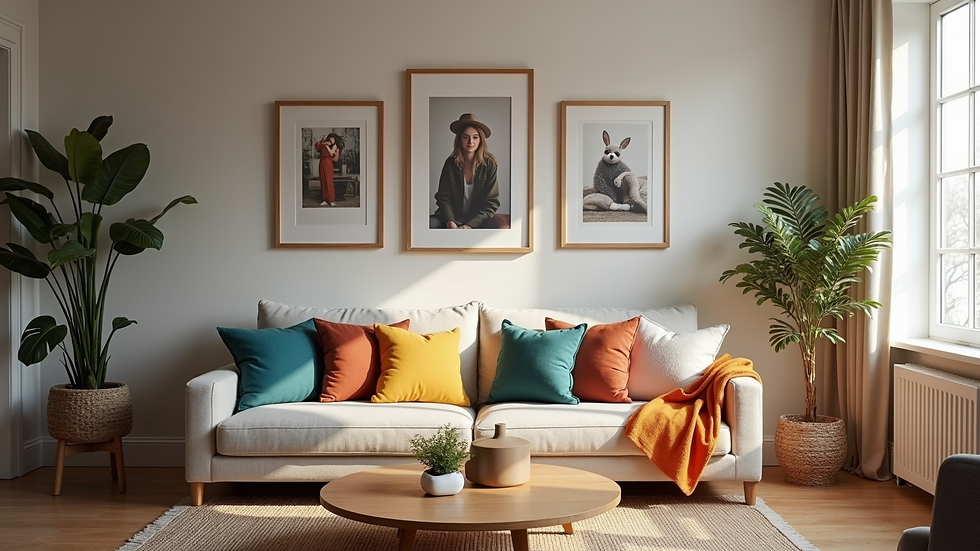Transform Your Space with Sustainable Solutions
- kristinavozarova04
- Nov 3
- 4 min read
Creating a living or working space that feels fresh, inviting, and responsible is a goal many people share today. The challenge lies in achieving this without harming the environment or draining resources. Sustainable solutions offer practical ways to transform your space while reducing your ecological footprint. This post explores how you can make your home or office greener, healthier, and more efficient with simple, effective changes.

Why Choose Sustainable Solutions for Your Space
Sustainability is no longer just a trend; it’s a necessity. Buildings and homes consume a significant portion of the world’s energy and resources. By adopting sustainable practices, you can:
Lower energy bills
Improve indoor air quality
Reduce waste and pollution
Create a healthier environment for yourself and others
These benefits make sustainable solutions a smart choice for anyone looking to improve their space.
Start with Energy Efficiency
One of the easiest ways to make your space more sustainable is by improving energy efficiency. This means using less energy to perform the same tasks, which saves money and reduces carbon emissions.
Upgrade to LED Lighting
Switching to LED bulbs cuts energy use by up to 75% compared to traditional incandescent bulbs. LEDs last longer and produce less heat, making them safer and more cost-effective.
Use Smart Thermostats
Smart thermostats learn your schedule and adjust heating or cooling accordingly. This prevents energy waste when rooms are empty and keeps your space comfortable.
Seal Windows and Doors
Drafts can cause heating and cooling systems to work harder. Use weatherstripping or caulk to seal gaps around windows and doors, improving insulation and reducing energy loss.
Choose Sustainable Materials
Materials used in furniture, flooring, and decor impact the environment. Opting for sustainable materials helps conserve resources and reduces pollution.
Bamboo and Cork Flooring
Bamboo grows quickly and regenerates without pesticides, making it a sustainable alternative to hardwood. Cork is harvested from tree bark without cutting down trees, offering a renewable flooring option.
Reclaimed Wood Furniture
Furniture made from reclaimed wood gives new life to old materials. It adds character to your space and reduces demand for new lumber.
Natural Fabrics
Choose curtains, upholstery, and rugs made from organic cotton, linen, or wool. These fabrics are biodegradable and often produced with fewer chemicals.
Incorporate Plants for Health and Beauty
Indoor plants do more than decorate. They improve air quality by filtering toxins and increase humidity, which benefits skin and respiratory health.
Easy-to-Care-For Plants
Snake plant
Spider plant
Pothos
Peace lily
These plants thrive indoors with minimal care and help create a calming atmosphere.
Vertical Gardens
If floor space is limited, vertical gardens or wall-mounted planters bring greenery into your space without clutter.
Reduce Waste with Smart Choices
Waste reduction is a key part of sustainability. Making mindful choices about what you buy and how you dispose of items can significantly cut down on landfill contributions.
Buy Secondhand or Upcycled Items
Thrift stores and online marketplaces offer quality furniture and decor at lower prices. Upcycling old items into new pieces adds uniqueness and reduces waste.
Use Reusable Containers and Bags
Avoid single-use plastics by switching to reusable containers for storage and shopping bags for errands.
Compost Organic Waste
If you have a garden or balcony, composting food scraps turns waste into nutrient-rich soil for plants.
Improve Water Efficiency
Water conservation helps protect this precious resource and lowers utility bills.
Install Low-Flow Fixtures
Low-flow faucets, showerheads, and toilets reduce water use without sacrificing performance.
Collect Rainwater
Rain barrels capture water for outdoor use, such as watering plants or cleaning.
Fix Leaks Promptly
Even small leaks can waste gallons of water over time. Regularly check and repair dripping faucets or pipes.
Use Non-Toxic Cleaning Products
Many conventional cleaning products contain chemicals that harm indoor air quality and the environment. Switching to natural or homemade cleaners keeps your space safe and fresh.
Simple DIY Cleaners
Vinegar and water for glass and surfaces
Baking soda for scrubbing
Lemon juice for deodorizing
These ingredients are affordable, effective, and eco-friendly.
Maximize Natural Light and Ventilation
Design your space to take advantage of natural light and airflow. This reduces the need for artificial lighting and mechanical cooling.
Window Treatments
Use light-colored curtains or blinds that allow sunlight while reducing glare.
Cross Ventilation
Arrange furniture and open windows on opposite sides to create airflow that cools your space naturally.
Sustainable Decorating Tips
Decorating sustainably means choosing items that last and have minimal environmental impact.
Choose Quality Over Quantity
Invest in fewer, well-made pieces that won’t need replacing soon.
Support Local Artisans
Buying from local makers reduces transportation emissions and supports the community.
Avoid Fast Furniture
Mass-produced, cheap furniture often uses harmful materials and ends up in landfills quickly.
Case Study: A Sustainable Living Room Makeover
Consider a homeowner who wanted to refresh their living room with sustainability in mind. They:
Replaced old bulbs with LEDs
Bought a reclaimed wood coffee table
Added a vertical garden on one wall
Used organic cotton curtains
Installed a smart thermostat
Switched to natural cleaning products
The result was a cozy, stylish space that lowered energy bills by 20% and improved air quality noticeably.
Take the First Step Today
Transforming your space with sustainable solutions does not require a complete overhaul. Start small by swapping light bulbs or adding a few plants. Each change adds up to a healthier environment and a more inviting space.
Think about what matters most to you—energy savings, air quality, or reducing waste—and focus your efforts there. Over time, these choices will create a space that feels good to live in and good for the planet.
Sustainable living is within reach. By making thoughtful choices, you can create a space that reflects your values and supports a better future. Start your transformation today and enjoy the benefits of a greener, healthier home or workspace.


Comments